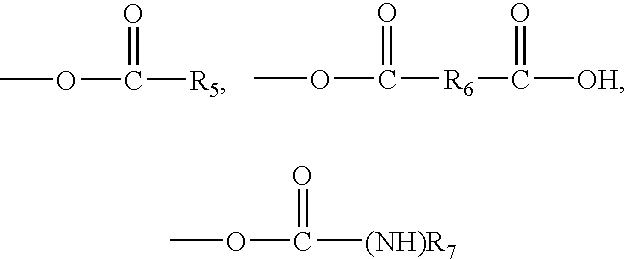Liquid admixture composition
a technology of liquid admixture and composition, which is applied in the direction of climate sustainability, solid waste management, sustainable waste treatment, etc., can solve the problems of mixing not being able to remain, slowing down the work on the job, and affecting the characteristics of final hardened products
- Summary
- Abstract
- Description
- Claims
- Application Information
AI Technical Summary
Problems solved by technology
Method used
Image
Examples
example 1.1
[0061] To a 1 liter four necked glass flask with a temperature controller, a reflux condenser and two dropping funnels 490.0 g water, 350.0 g (0.06 mol) polyethylene glycol-5800-monovinylether and 10.0 g NaOH (20%) were added. An mixture comprising 26.0 g (0.36 mol) of acrylic acid in 40.0 g water was produced separately and then was added to the polyethylene glycol-monovinylether-solution; the pH decreased to 5.3. Then 40.0 mg iron(II)sulfate-heptahydrate (“green vitriol”) and 4.0 g Rongalite™ and 1.5 g mercaptoethanol was added. After a short period of stirring 3.6 g 50% hydrogen peroxide was added. The temperature increased from 20 to 29° C. Then the solution was stirred for 10 minutes at ambient temperature and was subsequently neutralized with 37.0 g of a 20% sodium hydroxide solution. The copolymeric dispersant was a light yellow colored, clear and aqueous polymer solution with a solid concentration of 40% by weight. To the copolymeric dispersant the antifoaming agent and the ...
example 1.2
[0062] To the flask according to Example 1 490 g water, 350.0 g (0.06 mol) polyethylene glycol-5800-monovinylether, 35.0 g (0.006 mol) of a mixed ethylene-propylene polyalkylene glycol-6000-monovinylether, having a 10% proplylene content, and 10.0 g NaOH (20%) were added. A mixture comprising 26.0 g (0.36 mol) of acrylic acid in 40.0 g water was produced separately and then been added to the polyethylene glycol-monovinylether-solution; the pH decreased to 5.3. Then 40.0 mg iron(II)sulfate-heptahydrate (“green vitriol”) and 4.0 g Rongalite™ and 1.5 g mercaptoethanol were added. After a short period of stirring 3.6 g 50% hydrogen peroxide were added. The temperature increased from 20 to 29° C. The solution was than stirred for 10 minutes at ambient temperature and was subsequently neutralized with 37.0 g of a 20% sodium hydroxide solution. The copolymeric dispersant was a light yellow colored, clear and aqueous polymer solution with a solid concentration of 40% by weight. To the copol...
PUM
| Property | Measurement | Unit |
|---|---|---|
| temperatures | aaaaa | aaaaa |
| temperatures | aaaaa | aaaaa |
| temperatures | aaaaa | aaaaa |
Abstract
Description
Claims
Application Information
 Login to View More
Login to View More - R&D
- Intellectual Property
- Life Sciences
- Materials
- Tech Scout
- Unparalleled Data Quality
- Higher Quality Content
- 60% Fewer Hallucinations
Browse by: Latest US Patents, China's latest patents, Technical Efficacy Thesaurus, Application Domain, Technology Topic, Popular Technical Reports.
© 2025 PatSnap. All rights reserved.Legal|Privacy policy|Modern Slavery Act Transparency Statement|Sitemap|About US| Contact US: help@patsnap.com



